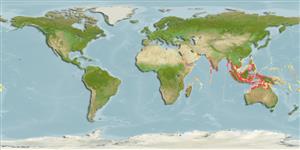Classification / Names
Common names | Synonyms | Catalog of Fishes (gen., sp.) | ITIS | CoL | WoRMS | Cloffa
Environment / Climate / Range
Ecology
Marine; brackish; demersal; amphidromous (Ref. 51243); depth range 1 - 40 m. Tropical, preferred ?
Indo-West Pacific: known only from Pakistan, India, and Thailand.
Size / Weight / Age
Maturity: Lm ? range ? - ? cm
Max length : 10.0 cm TL male/unsexed; (Ref. 3424); common length : 8.0 cm TL male/unsexed; (Ref. 3424)
Dorsal
spines
(total): 8;
Dorsal
soft rays
(total): 16;
Anal
spines: 3;
Anal
soft rays: 14. This species is distinguished by having the following set of characters: fully scaled breast; naked cheek; anteroventral profile of lower jaw is almost straight; a distinct, jet-black blotch distally on the spinous dorsal fin (Ref. 74926).
Found on shallow waters near the bottom. Young enter brackish waters (Ref. 4833). Feeds mainly on small crustaceans, foraminiferans and nematodes. Sold fresh and dried salted in markets, also used for fishmeal.
Life cycle and mating behavior
Maturity | Reproduction | Spawning | Eggs | Fecundity | Larvae
Kimura, S., R. Kimura and K. Ikejima, 2008. Revision of the genus Nuchequula with descriptions of three new species (Perciformes: Leiognathidae). Ichthyol. Res. 55:22-42. (Ref. 74926)
IUCN Red List Status (Ref. 115185)
CITES (Ref. 94142)
Not Evaluated
Threat to humans
Harmless
Human uses
Fisheries: commercial
More information
ReferencesAquacultureAquaculture profileStrainsGeneticsAllele frequenciesHeritabilityDiseasesProcessingMass conversion
Tools
Special reports
Download XML
Internet sources
Estimates of some properties based on models
Phylogenetic diversity index (Ref.
82805): PD
50 = 0.5078 [Uniqueness, from 0.5 = low to 2.0 = high].
Bayesian length-weight: a=0.01349 (0.00698 - 0.02607), b=3.06 (2.89 - 3.23), in cm Total Length, based on LWR estimates for this species & (Sub)family-body (Ref.
93245).
Trophic Level (Ref.
69278): 2.9 ±0.29 se; Based on food items.
Resilience (Ref.
69278): High, minimum population doubling time less than 15 months (K=1.25-1.16).
Vulnerability (Ref.
59153): Low vulnerability (11 of 100) .
